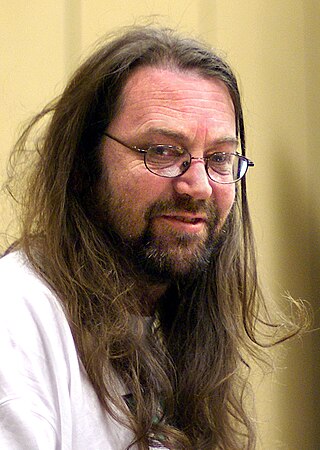
Jeff Minter is an English video game designer and programmer who often goes by the name Yak. He is the founder of software house Llamasoft and has created dozens of games during his career, which began in 1981 with games for the ZX80. Minter's games are shoot 'em ups which contain titular or in-game references demonstrating his fondness of ruminants. Many of his programs also feature something of a psychedelic element, as in some of the earliest "light synthesizer" programs including Trip-a-Tron.
A killer application is any software that is so necessary or desirable that it proves the core value of some larger technology, such as its host computer hardware, video game console, software platform, or operating system. Consumers would buy the host platform just to access that application, possibly substantially increasing sales of its host platform.
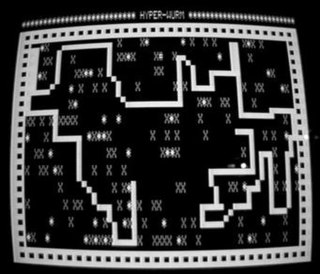
Snake is a genre of action video games where the player maneuvers the end of a growing line, often themed as a snake. The player must keep the snake from colliding with both other obstacles and itself, which gets harder as the snake lengthens. It originated in the 1976 two-player arcade video game Blockade from Gremlin Industries where the goal is to survive longer than the other player. The concept evolved into a single-player variant where a snake gets longer with each piece of food eaten—often apples or eggs. The simplicity and low technical requirements of snake games have resulted in hundreds of versions—some of which have the word snake or worm in the title—for many platforms.
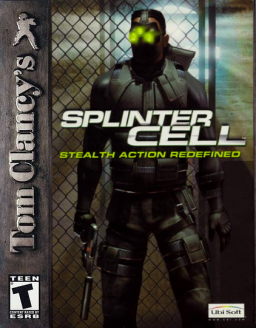
Tom Clancy's Splinter Cell is a 2002 stealth game developed by Ubisoft Montreal and published by Ubisoft. It is the first game in the Splinter Cell series. Endorsed by author Tom Clancy, it follows the activities of NSA black ops agent Sam Fisher. The game was inspired by both the Metal Gear series and games created by Looking Glass Studios, and was built using Unreal Engine 2.
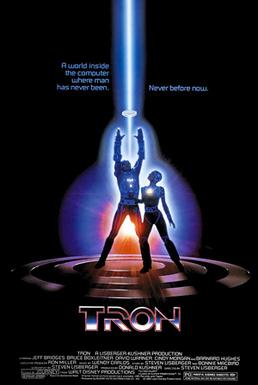
Tron is a 1982 American science fiction action adventure film written and directed by Steven Lisberger from a story by Lisberger and Bonnie MacBird. The film stars Jeff Bridges as Kevin Flynn, a computer programmer and video game developer who is transported inside the software world of a mainframe computer where he interacts with programs in his attempt to escape; it also stars Bruce Boxleitner, David Warner, Cindy Morgan, and Barnard Hughes. Tron, along with The Last Starfighter, was one of cinema's earliest films to use extensive computer-generated imagery (CGI).

Star Wars: Knights of the Old Republic is a role-playing video game developed by BioWare and published by LucasArts. The first installment of the Star Wars: Knights of the Old Republic series, it was released for the Xbox on July 16, 2003, and for Microsoft Windows on November 19, 2003. It was ported to Mac OS X, iOS, and Android by Aspyr, and it is playable on the Xbox 360, Xbox One, and Xbox Series X and Series S via backward compatibility. A Nintendo Switch version was released on November 11, 2021.

James Bond 007: Nightfire is a 2002 first-person shooter video game published by Electronic Arts for the GameCube, PlayStation 2, Xbox and Microsoft Windows, with additional versions released for the Game Boy Advance in 2003, and the Mac OS X in 2004. The computer versions feature modifications to the storyline, different missions and the removal of driving sections used in home console versions.

Tron is a coin-operated arcade video game manufactured and distributed by Bally Midway in 1982. The game consists of four subgames inspired by the events of the Walt Disney Productions motion picture Tron released earlier in the summer. The lead programmer was Bill Adams. The music programmer was Earl Vickers.
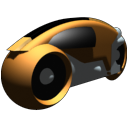
The Light Cycle is a type of fictional motorcycle featured in the Tron franchise. First introduced in the film Tron, they are used as part of a deadly virtual game conducted by the villainous Master Control Program. In it, players must ride around an arena without crashing into each other, the outer walls, or the light trails left behind by the vehicles. Subsequent generations of Light Cycles appeared in later works of media.
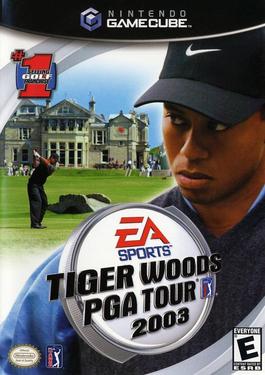
Tiger Woods PGA Tour 2003 is a sports video game developed by EA Redwood Shores for the Xbox, PlayStation 2 and GameCube versions and Headgate Studios for the Microsoft Windows and Mac OS versions and published by EA Sports.

Tiger Woods PGA Tour 2004 is a sports video game developed by EA Redwood Shores for the GameCube, PlayStation 2 and Xbox versions, Headgate Studios for the Microsoft Windows version, and Backbone Emeryville for the Game Boy Advance and N-Gage versions, and published by EA Sports for GameCube, Microsoft Windows, PlayStation 2, Xbox, Game Boy Advance and N-Gage.

Bloom is a computer graphics effect used in video games, demos, and high-dynamic-range rendering (HDRR) to reproduce an imaging artifact of real-world cameras. The effect produces fringes of light extending from the borders of bright areas in an image, contributing to the illusion of an extremely bright light overwhelming the camera or eye capturing the scene. It became widely used in video games after an article on the technique was published by the authors of Tron 2.0 in 2004.

Tron: Legacy is a 2010 American science fiction action film directed by Joseph Kosinski from a screenplay by Adam Horowitz and Edward Kitsis, based on a story by Horowitz, Kitsis, Brian Klugman, and Lee Sternthal. It serves as a sequel to Tron (1982), whose director Steven Lisberger returned to co-produce. The cast includes Jeff Bridges and Bruce Boxleitner reprising their roles as Kevin Flynn and Alan Bradley, respectively, as well as Garrett Hedlund, Olivia Wilde, James Frain, Beau Garrett, and Michael Sheen. The story follows Flynn's adult son Sam, who responds to a message from his long-lost father and is transported into a virtual reality called "the Grid", where Sam, his father, and the algorithm Quorra must stop the malevolent program Clu from invading the real world.

Tron: Evolution is a 2010 action-adventure game published by Disney Interactive Studios. It serves as a tie-in to the 2010 film Tron: Legacy, with its game taking place before the events of the film. It was announced at the 2009 Spike Video Game Awards and was released for Microsoft Windows, Xbox 360, PlayStation 3, and PlayStation Portable. It was released on November 25, 2010, in Australia, November 26, 2010, in Europe, and December 7, 2010, in North America and Asia.
Tron is an American science fiction media franchise created by Steven Lisberger and Bonnie MacBird. It began with the eponymous 1982 film produced by Walt Disney Pictures. The original film portrays Jeff Bridges as Kevin Flynn, a genius computer programmer and video game developer who becomes transported inside a digital virtual reality known as "The Grid", where he interacts with programs in his quest to escape.

"Derezzed" is an instrumental song written, produced and performed by Daft Punk for the soundtrack of the motion picture Tron: Legacy, available on the album of the same name. As a pre-order bonus for the album on the iTunes Store, "Derezzed" was released by Walt Disney Records as a single on December 8, 2010. It was remixed by The Glitch Mob and Avicii for the remix albums Tron: Legacy Reconfigured and Dconstructed. "Derezzed" was also included on a 4-track vinyl EP titled Translucence, released by Walt Disney Records.















